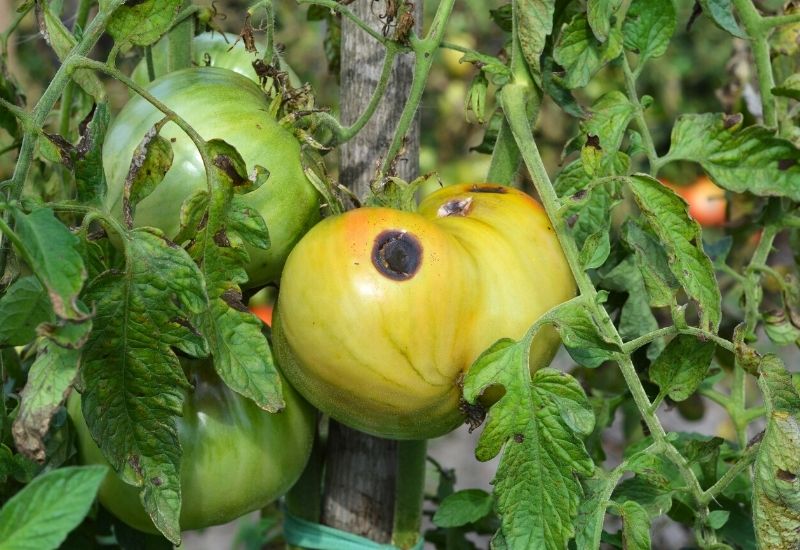
Growing tomatoes at home has its challenges, and one of the most common is noticing black spots appearing on tomato fruits.
What are these black spots on my tomatoes? What causes them? And how can they be treated?
Black spots on tomato fruits are usually caused by blossom end rot or several different disease pathogens.
There are no causes that are 100% reversible and no treatments will completely undo the damage already done to fruits, however there are ways to limit the spread of black spots and treat any underlying causes.
If you are struggling with the emergence of mysterious black spots on your otherwise beautiful tomato fruits, read on about how to diagnose your plants and take the necessary action to prevent it from happening again.
What Causes Black Spots on Tomato Fruit?
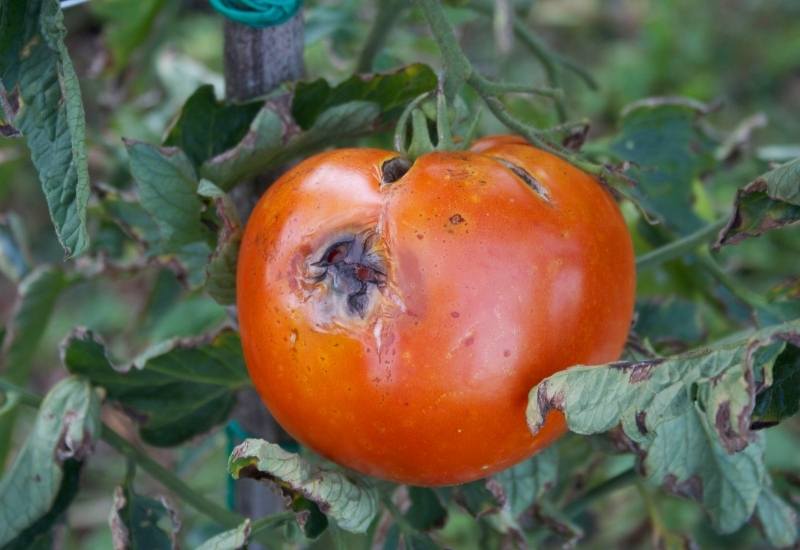
The most likely cause of black spots on your tomato fruits is blossom end rot, which is a result of a calcium deficiency in your plant.
There may be insufficient calcium levels in your soil, but it is more commonly brought on by inconsistent watering patterns which impede the ability of your tomato plant to uptake calcium.
Overwatering, underwatering, or frequently alternating between the two can create this effect, as can growing plants in acidic soils with a pH below 5.5.
The over-application of nitrogen fertilizers is also thought to impede calcium uptake, especially when combined with watering issues or a low soil pH.
Blossom end rot is more likely to occur after very hot or dry weather and on earlier ripening fruits in the middle of summer, around July and August.
Bacterial and fungal diseases are also possible causes for the development of black spots on tomatoes, like those caused by Alternaria Canker, Bacterial Speck, and Anthracnose, all which will typically show other symptoms in addition to spots on fruits.
1: Alternaria Canker is caused by a fungal pathogen and primarily affects the stem and leaves of tomato plants, but will also exhibit black spots on fruits.
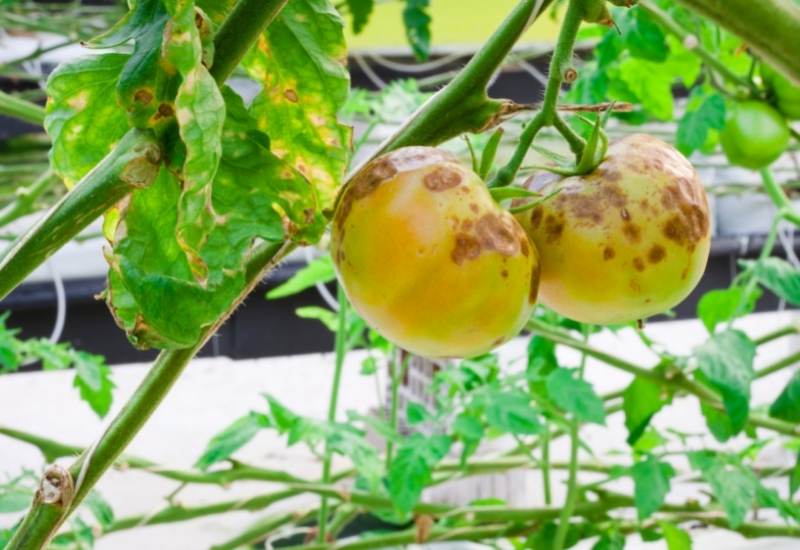
This fungal disease is spread through spores that can survive on plant debris, in the soil, or can be transported through the wind and land on plants.
Moisture is necessary for this disease to spread, so rainy weather or water splashing or sitting on leaves after irrigation will encourage it to propagate in your garden.
2: Bacterial Speck is caused by the bacteria P. syringae which might be present in infected seeds or seedlings, and can also overwinter on plant debris or garden equipment like trellises or stakes. This pathogen also spreads most efficiently in damp conditions, especially when the weather is cool at around 70℉ (~21℃).
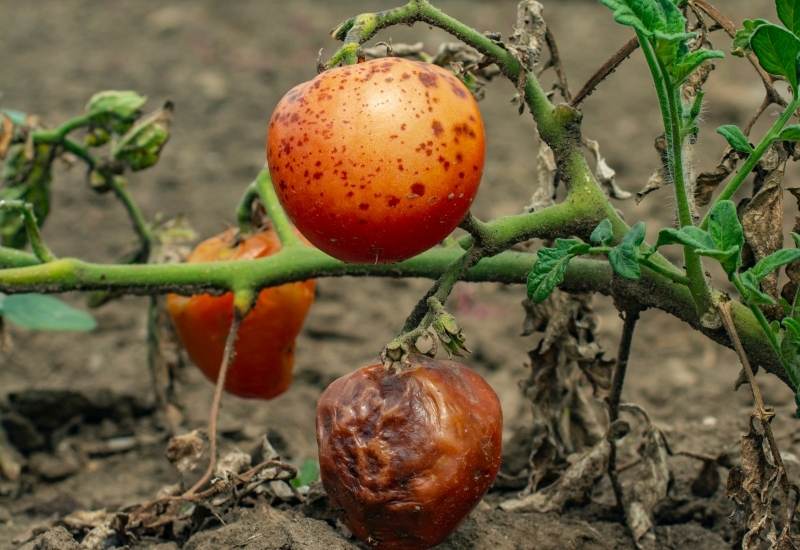
3: Anthracnose is caused by several different fungal species that infect tomato fruits when they are green and unripe but will typically only show their symptoms once fruits have ripened. This disease is caused by the spread of spores through water splashing from infected fruits to other fruits, and may also survive in the saved seeds of infected plants.
How to Identify the Causes of Black Spots

A key step in treating the emergence of black spots or rotting patches on your tomatoes is correctly diagnosing the issue.
Since some of these issues will affect other parts of the tomato plant or quickly spread to other plants, it’s important to try and identify the cause as soon as you can by carefully assessing all the symptoms.
Here’s how to do this for the four main causes listed above:
1: Blossom end rot
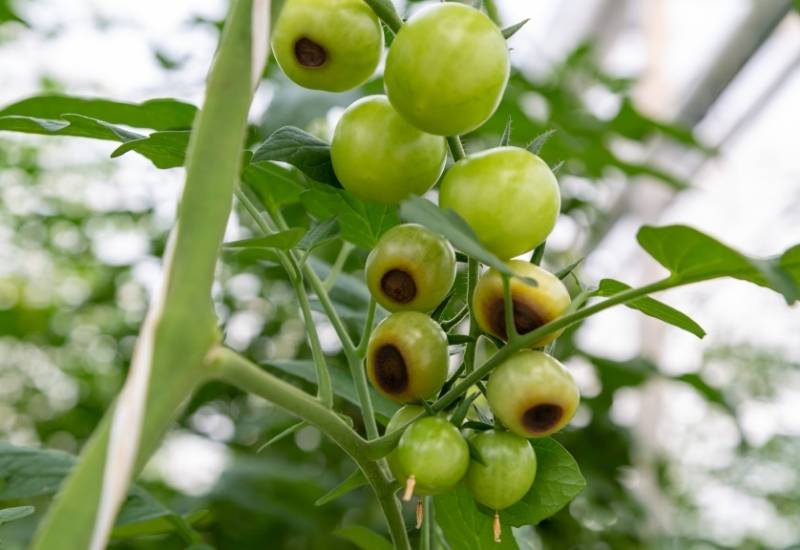
Blossom end rot often emerges while fruits are still unripe and green, with small, wet brown patches forming on the underside of fruits where the blossom was initially attached.
They always occur in this location, never on the sides or on top of the fruit anywhere near the stem.
The branches and leaves will usually remain unaffected, but multiple fruits on the same plant will often show signs of infection since the whole plant is struggling with a calcium deficiency.
The spots become larger and more sunken as the fruits grow and ripen, and can eventually cover and damage the entire bottom of the fruit.
2: Alternaria Canker
Alternaria Canker, also called Alternaria Stem Canker, will primarily affect the stem of your tomato plant, which is also the best way to distinguish it from other diseases.
The bottom of the stem, a couple inches above the soil line, will typically turn brown and water-soaked in a state called collar rot, and more streaky brown lesions will appear along the stem and branches.
Dark brown spots will emerge on the tomato leaves and fruits, and those on the tomato fruits will also have concentric rings inside that look distinct from blossom end rot.
3: Bacterial Speck
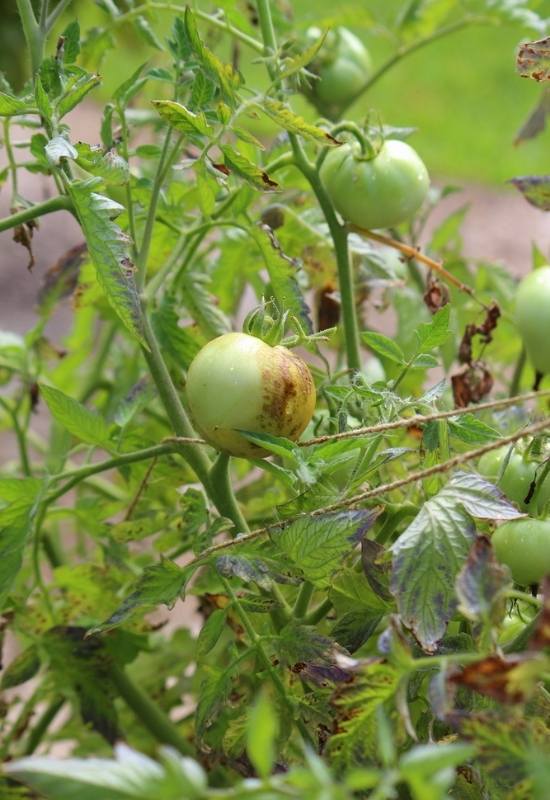
Black spots caused by Bacterial Speck are very small, like tiny needle pricks, and occur in clusters on unripe tomatoes or the underside of leaves.
They are much smaller than the black spots of other causes on this list and also much shallower. They sometimes are surrounded by a light green halo on fruits and a yellow halo on leaves.
4: Anthracnose
Anthracnose spots start out small but grow quickly into wide, flattened patches on your ripening and overripe tomatoes, with a black centre where spores are developed.
These patches may also crack and become a point of entry for other diseases or insects that will speed up the rotting process.
These patches can occur anywhere around the fruits, and typically affect lower-hanging fruits first which are more exposed to the pathogen splashing up from the soil.
How to Manage Black Spots
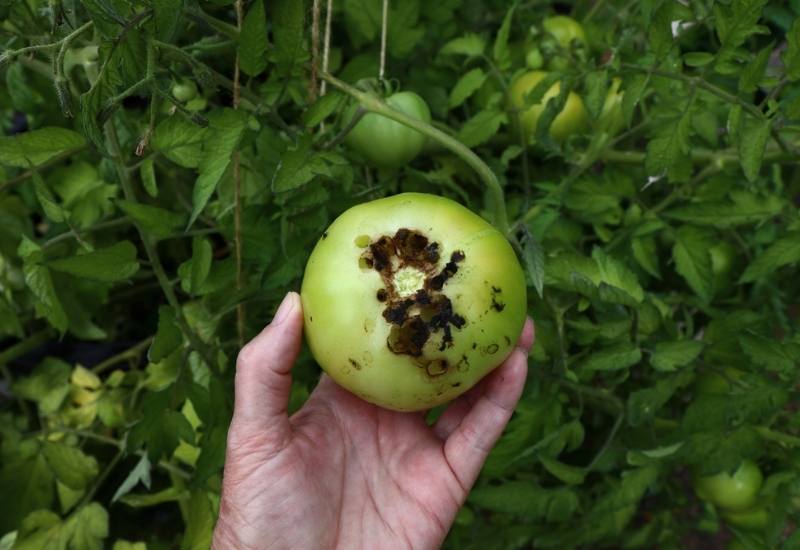
There is no way to reverse the development of black spots once they have already formed, as dead or rotted tissue cannot be restored into healthy tissue.
You can, however, stop the spread of these spots so that the majority of already infected fruits can be salvaged and uninfected fruits are protected.
1: How to Prevent Blossom-End Rot
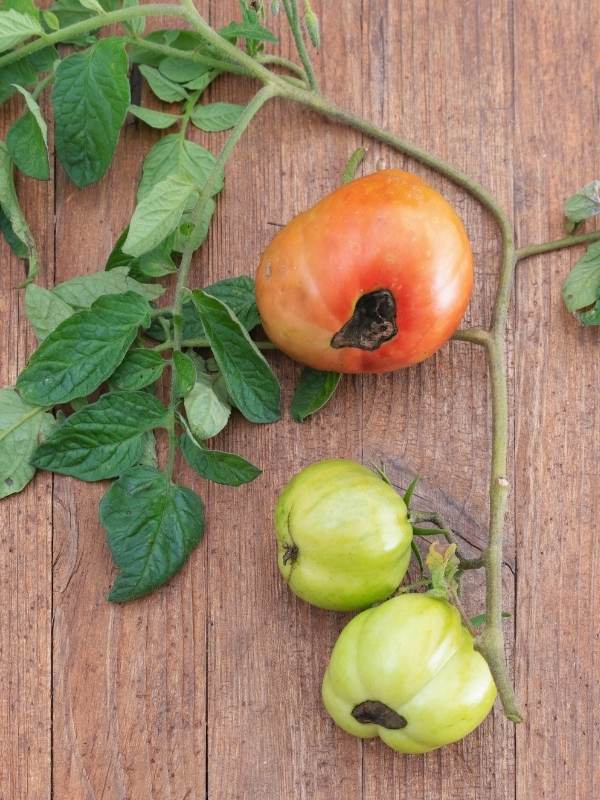
Pick affected fruits and immediately put your plants on a consistent watering schedule. You can eat fruits with blossom end rot, just consume them as soon as possible and cut off the rotted part.
Although you might think applying a calcium fertilizer will fix the issue, this will usually just cause more problems from overfertilization as most soils already have enough calcium; it’s just the plants that are unable to uptake it.
To raise pH in very acidic conditions, you can add lime or chalk particles to your soil, or ash from a wood-burning stove.
Picking fruits that are already rotting will cause your tomato plant to refocus its energy on the other, unaffected fruits and as long as you fix any watering or pH issues, the rest of the fruits stand a chance at not developing this rot.
2: How to Prevent Alternaria canker
Copper fungicides have been cited as successful in organically treating Alternaria canker, and can be applied to all parts of the plant that are infected in addition to the pruning of severely damaged branches and fruits.
For advanced cases, pull up the plant and destroy it before the disease spreads throughout your garden.
3: How to Control Bacterial Spots on Tomatoes
Harvest unaffected fruits for indoor ripening and pull up the rest of the tomato plant, as Bacterial Speck will just continue to spread throughout the rest of the season.
Dispose of plants and plant debris appropriately to prevent the disease from surviving in your garden. Do not eat fruits that have spots on them.
4: How To Manage Tomato Anthracnose Symptoms
Harvest fruits as soon as they ripen and the moment that you see any initial signs of Anthracnose. Fruits that are just beginning to look bruised or have sunken patches can be eaten, just cut away the infected parts.
This will prevent the spores from spreading to other ripe or ripening fruits in your tomato patch, as it is prone to doing in harvest season.
Tips to Prevent Black Spots and Rot on Tomatoes

To prevent having to deal with black spots at all, there are several important steps to take that protect your plants from developing blossom end rot or becoming prey to fungal and bacterial diseases.
Plants in good health generally are less vulnerable to infections, so in addition to these preventative measures make sure you are following all other plant care guidelines to keep them happy and healthy.
Water Plants At Root Level And Consistently
All of the causes of black spots on this list are related to watering issues.
Blossom end rot is most commonly triggered by watering inconsistencies that create an inability for the tomato plant to absorb calcium, and all of the other diseases spread and contaminate plants more effectively in damp and humid conditions when water is left to sit on the leaves of plants.
Avoid overhead irrigation systems, like sprinklers, and opt for soil level watering with soaker hoses or drip irrigation.
Consistency is key, and tomato plants need about one inch of moisture per week, so water deeply once or twice a week but adjust as necessary for rain or dry spells.
Mulch The Soil Surface With Straw
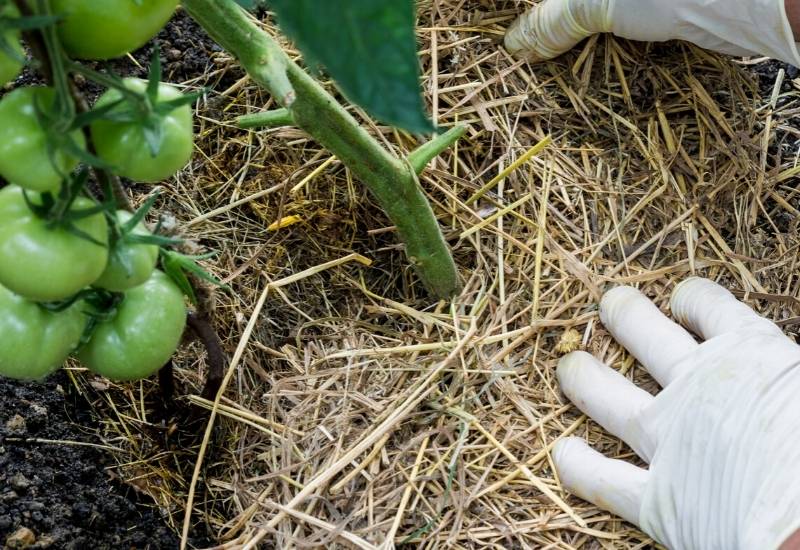
Mulches conserve soil moisture and also act as a physical barrier between the soil surface and lower branches or low-hanging tomato fruit that are subject to becoming infected with disease.
Make sure the mulch doesn’t actually touch the main stem of your plant, as the wet material can cause it to rot with constant contact.
Straw is a good mulch for tomato plants as the light color won’t cause the soil to heat up or dry out quickly.
Don’t Over Fertilize
Blossom end rot is commonly caused by overfertilizing your tomato plants with nitrogen-based fertilizers, which affect the plants ability to uptake calcium.
However, you also shouldn’t just flood your plants with calcium fertilizer to prevent blossom end rot, as most soils have sufficient amounts and it is other factors that block its access from the plant.
In a few cases you may have insufficient calcium levels in your soil, but you should always test soil before adding calcium fertilizer to confirm that this is the issue.
Avoid Disturbing The Roots After Planting
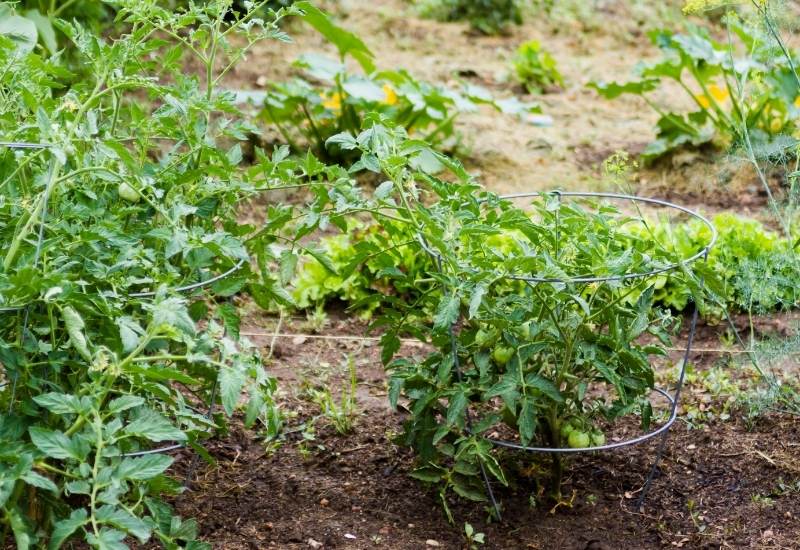
Roots are how your tomato plant absorbs water and nutrients from the soil, and damaging them can cause the plant to go into stress or impede the plants ability to take up moisture- causing blossom end rot.
Install trellises prior to or at the same time as planting or transplanting to prevent ripping already established roots, and ward off burrowing animals from your garden with scent deterrents like apple cider vinegar.
Harvest Fruits When Ripe
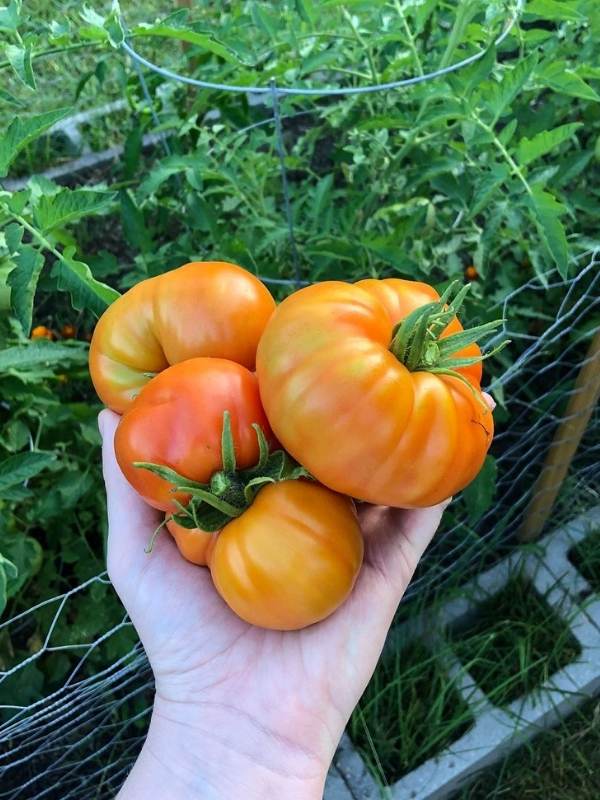
Anthracnose typically only affects fruits once they have hit ripeness or become overripe, so harvesting fruits promptly once their color fills out can reduce the likelihood of them developing large rotted or bruised patches.
The longer ripe fruits hang on the vine the more they are susceptible to invasion from pests, other diseases, or to being eaten by animals, so it is generally a good practice anyway.
If a heavy rain event is forecasted and fruits are almost ripe but not quite there yet, harvest fruits preemptively and just let them ripen indoors to prevent fruits from splitting or disease pathogens spreading in the moisture.
Buy Resistant Cultivars When Possible
You can purchase tomato varieties that are resistant to Alternaria Canker and Anthracnose to save yourself the stress of losing your otherwise healthy tomato fruits later in the season.
Since blossom end rot is not a disease but the result of a deficiency, there are no totally resistant cultivars but there are some that have a higher tolerance for the symptoms like ‘Mountain Delight’ or ‘Mountain Spring’. ‘Chef’s Choice Orange’ is a great tomato with good resistance to Anthracnose, and ‘Juliet’, ‘Ace 55’, and ‘Golden Jubilee’ are resistant to Alternaria Canker.
Trellis Plants And Prune Lower Tomato Branches
Anthracnose and Alternaria Canker can both splash up onto your tomato fruits and branches from the soil during a rainstorm, so keeping your plants off the ground and removing any unnecessary lower branches can limit the chances of infection.
Trellising plants is a good practice in general, as it increases airflow and reduces the local humidity around the plant by allowing sunshine and wind to quickly dry any wet leaves.

Written By
Amber Noyes
Amber Noyes was born and raised in a suburban California town, San Mateo. She holds a master’s degree in horticulture from the University of California as well as a BS in Biology from the University of San Francisco. With experience working on an organic farm, water conservation research, farmers’ markets, and plant nursery, she understands what makes plants thrive and how we can better understand the connection between microclimate and plant health. When she’s not on the land, Amber loves informing people of new ideas/things related to gardening, especially organic gardening, houseplants, and growing plants in a small space.
